BSc Business Management: Analyzing Employee Motivation and Strategies
VerifiedAdded on 2023/06/14
|9
|1859
|373
Report
AI Summary
This report provides an analysis of employee motivation in the workplace, focusing on factors that influence employee performance and job satisfaction. It delves into Maslow's Hierarchy of Needs, differentiating between extrinsic and intrinsic motivation. The report identifies various motivating factors such as salary, promotion opportunities, and a positive work environment. It also addresses the positive factors employees experience, including growth opportunities and skill development, alongside negative factors like lack of motivation and workplace disputes. The report concludes with strategies to cope with these negative factors, emphasizing effective communication and motivational practices. The analysis underscores the importance of a positive and motivating work environment in enhancing employee engagement and productivity. Desklib offers a wealth of similar resources for students.
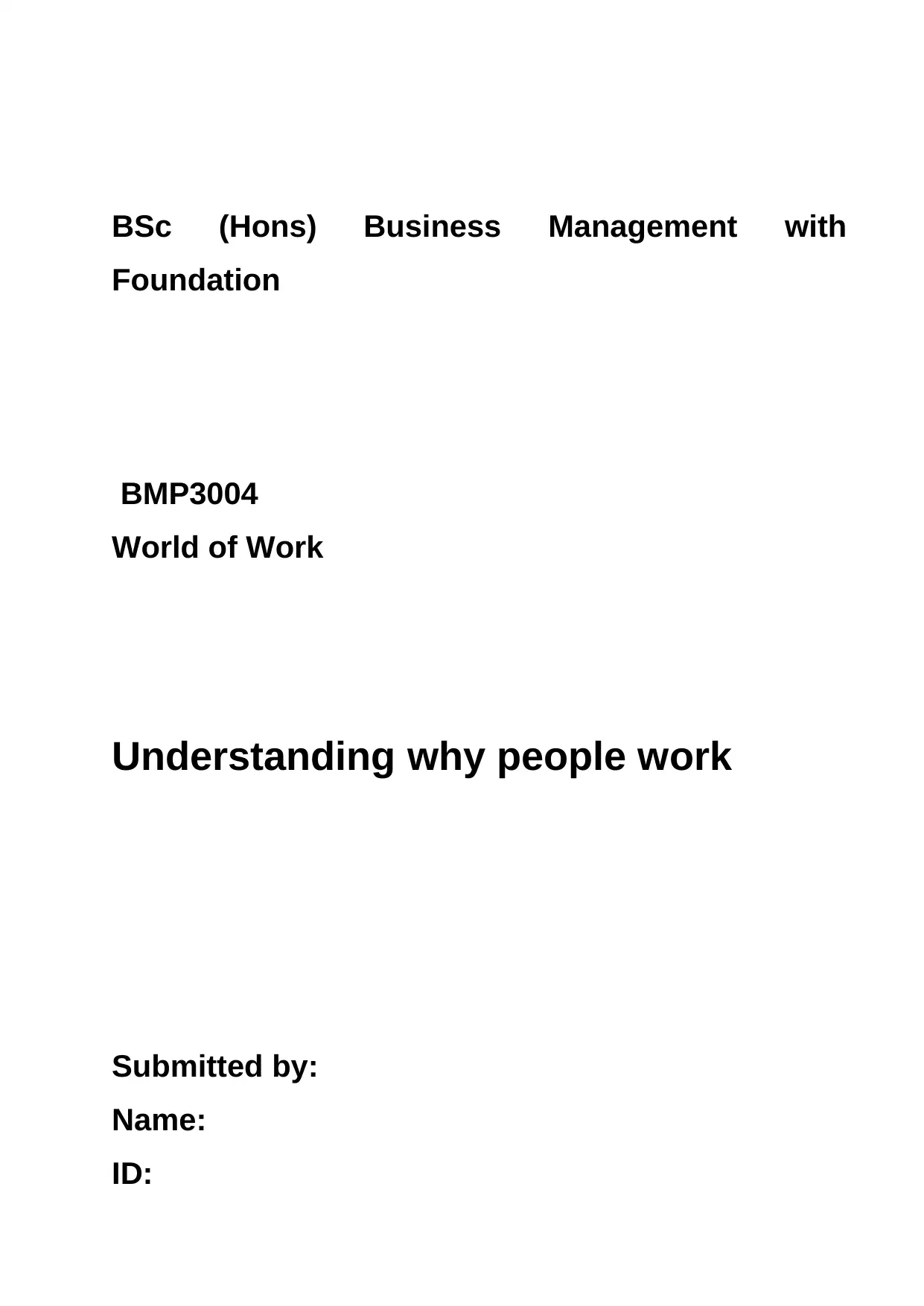
BSc (Hons) Business Management with
Foundation
BMP3004
World of Work
Understanding why people work
Submitted by:
Name:
ID:
Foundation
BMP3004
World of Work
Understanding why people work
Submitted by:
Name:
ID:
Paraphrase This Document
Need a fresh take? Get an instant paraphrase of this document with our AI Paraphraser
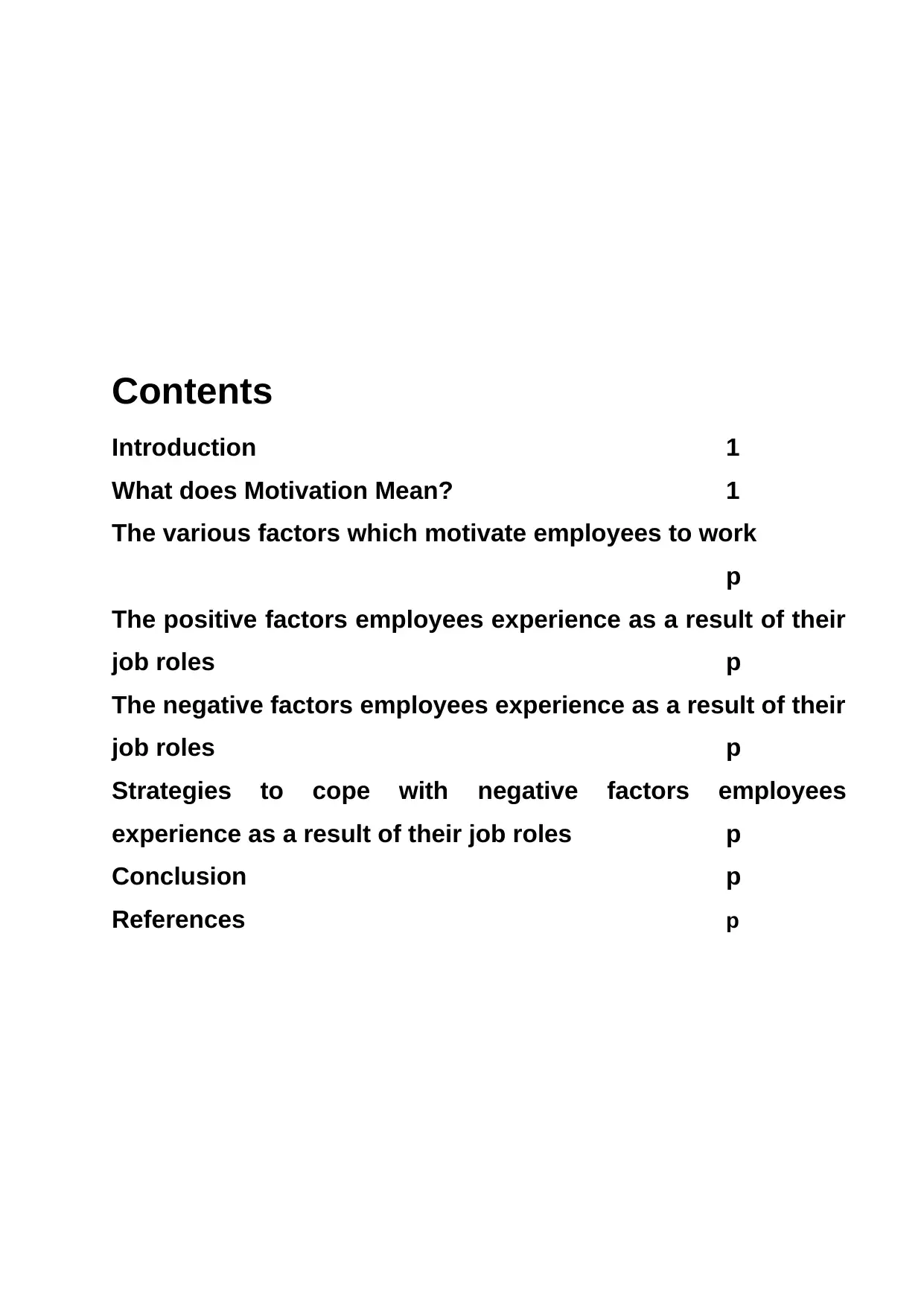
Contents
Introduction 1
What does Motivation Mean? 1
The various factors which motivate employees to work
p
The positive factors employees experience as a result of their
job roles p
The negative factors employees experience as a result of their
job roles p
Strategies to cope with negative factors employees
experience as a result of their job roles p
Conclusion p
References p
Introduction 1
What does Motivation Mean? 1
The various factors which motivate employees to work
p
The positive factors employees experience as a result of their
job roles p
The negative factors employees experience as a result of their
job roles p
Strategies to cope with negative factors employees
experience as a result of their job roles p
Conclusion p
References p
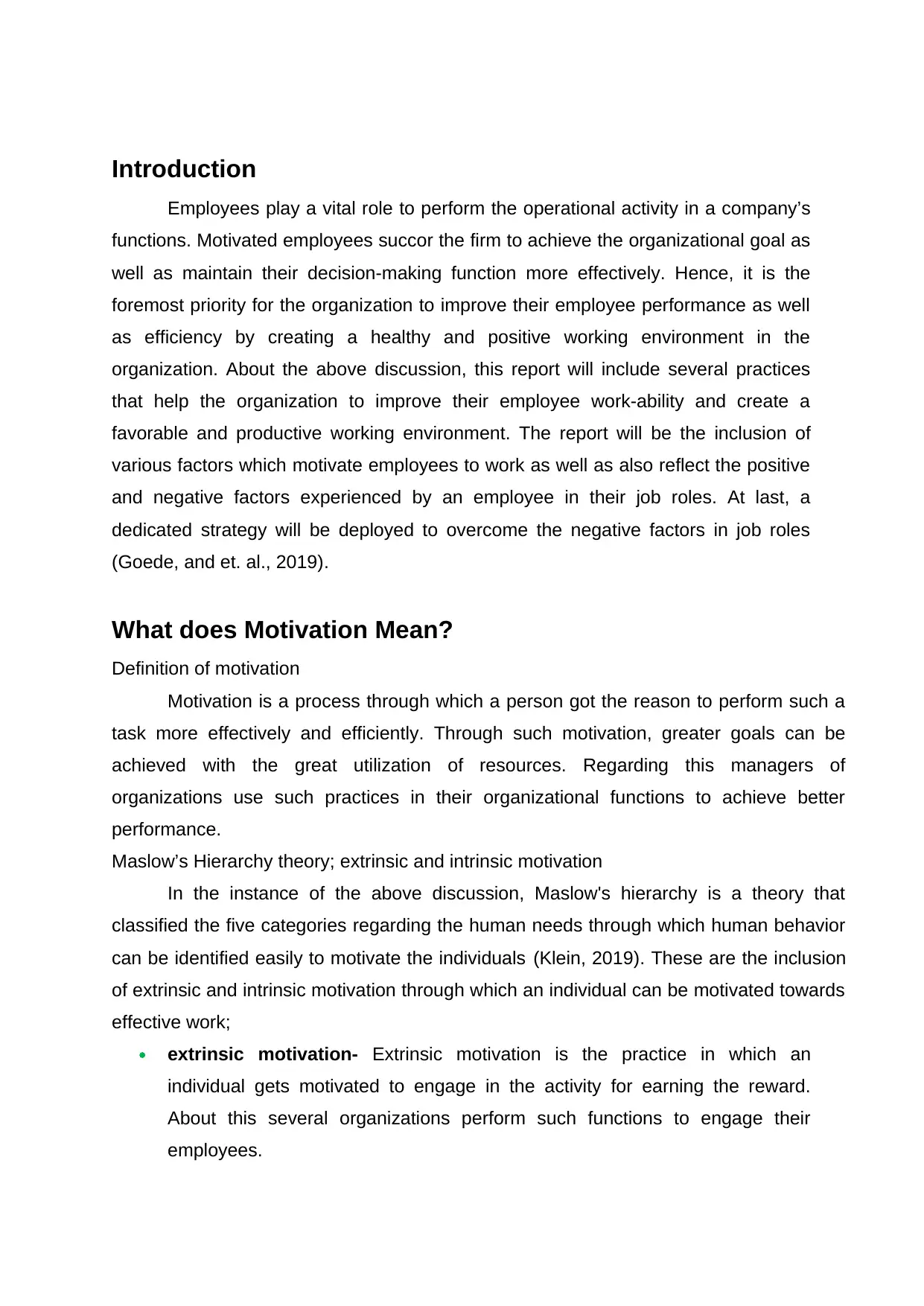
Introduction
Employees play a vital role to perform the operational activity in a company’s
functions. Motivated employees succor the firm to achieve the organizational goal as
well as maintain their decision-making function more effectively. Hence, it is the
foremost priority for the organization to improve their employee performance as well
as efficiency by creating a healthy and positive working environment in the
organization. About the above discussion, this report will include several practices
that help the organization to improve their employee work-ability and create a
favorable and productive working environment. The report will be the inclusion of
various factors which motivate employees to work as well as also reflect the positive
and negative factors experienced by an employee in their job roles. At last, a
dedicated strategy will be deployed to overcome the negative factors in job roles
(Goede, and et. al., 2019).
What does Motivation Mean?
Definition of motivation
Motivation is a process through which a person got the reason to perform such a
task more effectively and efficiently. Through such motivation, greater goals can be
achieved with the great utilization of resources. Regarding this managers of
organizations use such practices in their organizational functions to achieve better
performance.
Maslow’s Hierarchy theory; extrinsic and intrinsic motivation
In the instance of the above discussion, Maslow's hierarchy is a theory that
classified the five categories regarding the human needs through which human behavior
can be identified easily to motivate the individuals (Klein, 2019). These are the inclusion
of extrinsic and intrinsic motivation through which an individual can be motivated towards
effective work;
extrinsic motivation- Extrinsic motivation is the practice in which an
individual gets motivated to engage in the activity for earning the reward.
About this several organizations perform such functions to engage their
employees.
Employees play a vital role to perform the operational activity in a company’s
functions. Motivated employees succor the firm to achieve the organizational goal as
well as maintain their decision-making function more effectively. Hence, it is the
foremost priority for the organization to improve their employee performance as well
as efficiency by creating a healthy and positive working environment in the
organization. About the above discussion, this report will include several practices
that help the organization to improve their employee work-ability and create a
favorable and productive working environment. The report will be the inclusion of
various factors which motivate employees to work as well as also reflect the positive
and negative factors experienced by an employee in their job roles. At last, a
dedicated strategy will be deployed to overcome the negative factors in job roles
(Goede, and et. al., 2019).
What does Motivation Mean?
Definition of motivation
Motivation is a process through which a person got the reason to perform such a
task more effectively and efficiently. Through such motivation, greater goals can be
achieved with the great utilization of resources. Regarding this managers of
organizations use such practices in their organizational functions to achieve better
performance.
Maslow’s Hierarchy theory; extrinsic and intrinsic motivation
In the instance of the above discussion, Maslow's hierarchy is a theory that
classified the five categories regarding the human needs through which human behavior
can be identified easily to motivate the individuals (Klein, 2019). These are the inclusion
of extrinsic and intrinsic motivation through which an individual can be motivated towards
effective work;
extrinsic motivation- Extrinsic motivation is the practice in which an
individual gets motivated to engage in the activity for earning the reward.
About this several organizations perform such functions to engage their
employees.
⊘ This is a preview!⊘
Do you want full access?
Subscribe today to unlock all pages.

Trusted by 1+ million students worldwide
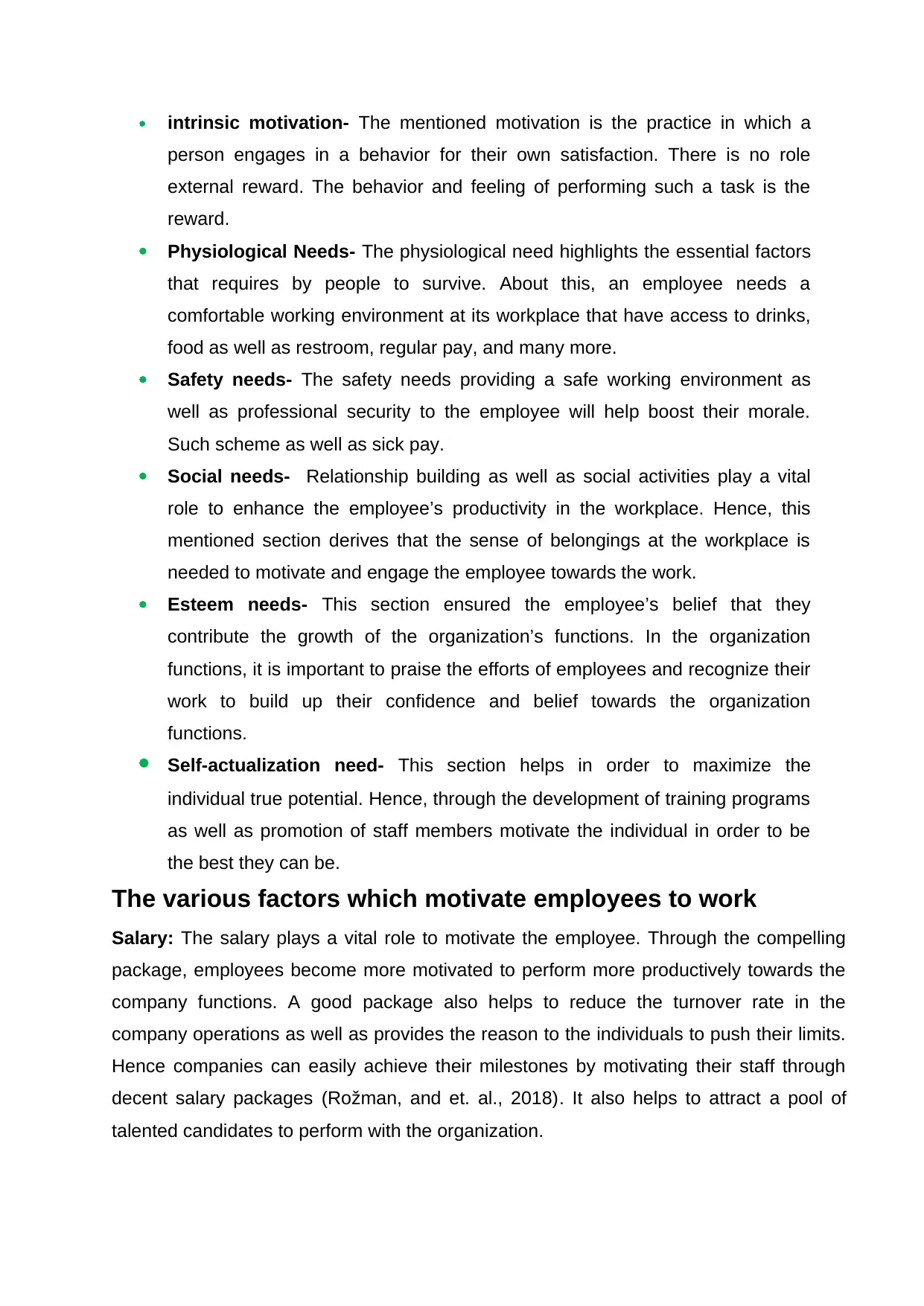
intrinsic motivation- The mentioned motivation is the practice in which a
person engages in a behavior for their own satisfaction. There is no role
external reward. The behavior and feeling of performing such a task is the
reward.
Physiological Needs- The physiological need highlights the essential factors
that requires by people to survive. About this, an employee needs a
comfortable working environment at its workplace that have access to drinks,
food as well as restroom, regular pay, and many more.
Safety needs- The safety needs providing a safe working environment as
well as professional security to the employee will help boost their morale.
Such scheme as well as sick pay.
Social needs- Relationship building as well as social activities play a vital
role to enhance the employee’s productivity in the workplace. Hence, this
mentioned section derives that the sense of belongings at the workplace is
needed to motivate and engage the employee towards the work.
Esteem needs- This section ensured the employee’s belief that they
contribute the growth of the organization’s functions. In the organization
functions, it is important to praise the efforts of employees and recognize their
work to build up their confidence and belief towards the organization
functions.
Self-actualization need- This section helps in order to maximize the
individual true potential. Hence, through the development of training programs
as well as promotion of staff members motivate the individual in order to be
the best they can be.
The various factors which motivate employees to work
Salary: The salary plays a vital role to motivate the employee. Through the compelling
package, employees become more motivated to perform more productively towards the
company functions. A good package also helps to reduce the turnover rate in the
company operations as well as provides the reason to the individuals to push their limits.
Hence companies can easily achieve their milestones by motivating their staff through
decent salary packages (Rožman, and et. al., 2018). It also helps to attract a pool of
talented candidates to perform with the organization.
person engages in a behavior for their own satisfaction. There is no role
external reward. The behavior and feeling of performing such a task is the
reward.
Physiological Needs- The physiological need highlights the essential factors
that requires by people to survive. About this, an employee needs a
comfortable working environment at its workplace that have access to drinks,
food as well as restroom, regular pay, and many more.
Safety needs- The safety needs providing a safe working environment as
well as professional security to the employee will help boost their morale.
Such scheme as well as sick pay.
Social needs- Relationship building as well as social activities play a vital
role to enhance the employee’s productivity in the workplace. Hence, this
mentioned section derives that the sense of belongings at the workplace is
needed to motivate and engage the employee towards the work.
Esteem needs- This section ensured the employee’s belief that they
contribute the growth of the organization’s functions. In the organization
functions, it is important to praise the efforts of employees and recognize their
work to build up their confidence and belief towards the organization
functions.
Self-actualization need- This section helps in order to maximize the
individual true potential. Hence, through the development of training programs
as well as promotion of staff members motivate the individual in order to be
the best they can be.
The various factors which motivate employees to work
Salary: The salary plays a vital role to motivate the employee. Through the compelling
package, employees become more motivated to perform more productively towards the
company functions. A good package also helps to reduce the turnover rate in the
company operations as well as provides the reason to the individuals to push their limits.
Hence companies can easily achieve their milestones by motivating their staff through
decent salary packages (Rožman, and et. al., 2018). It also helps to attract a pool of
talented candidates to perform with the organization.
Paraphrase This Document
Need a fresh take? Get an instant paraphrase of this document with our AI Paraphraser
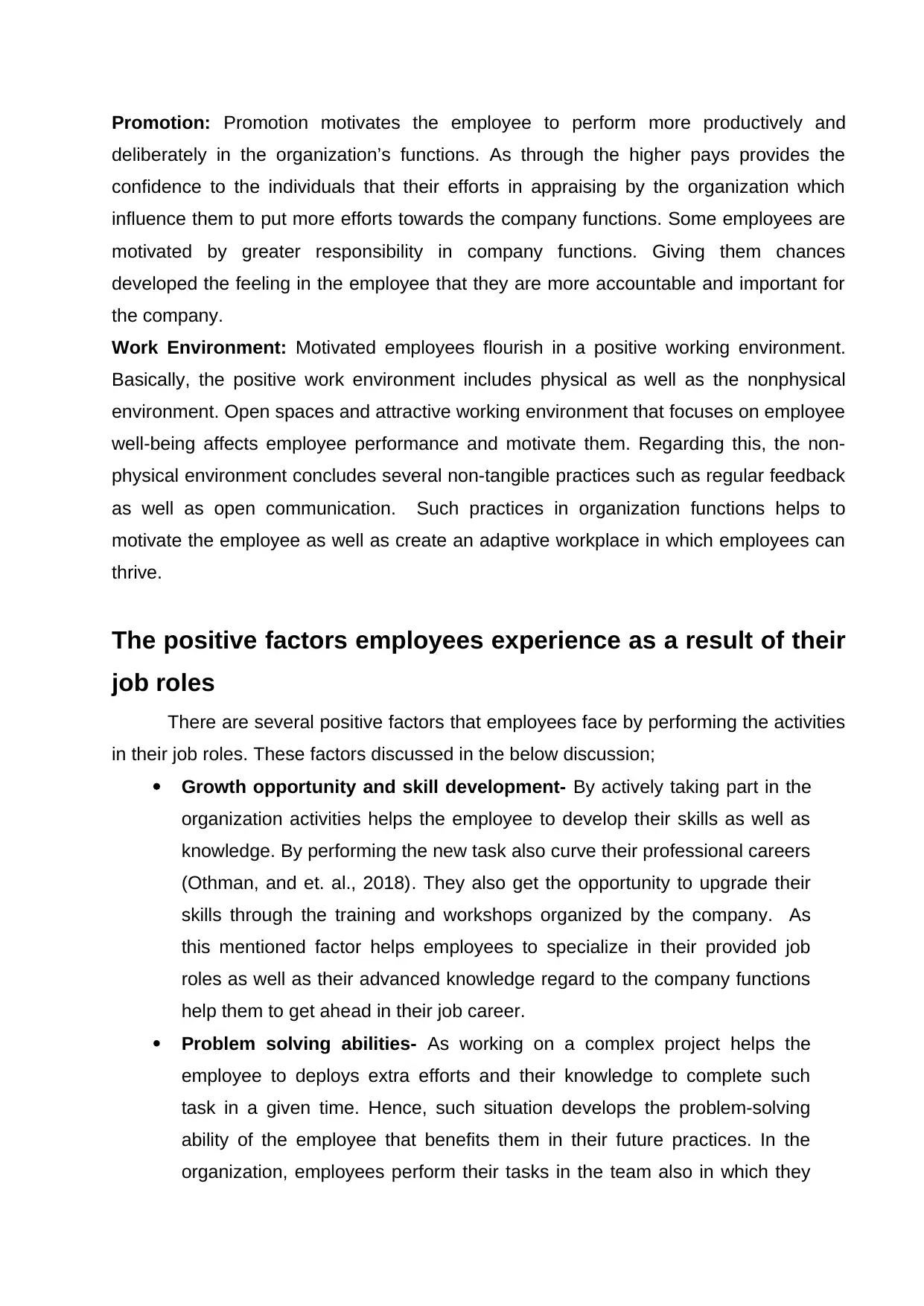
Promotion: Promotion motivates the employee to perform more productively and
deliberately in the organization’s functions. As through the higher pays provides the
confidence to the individuals that their efforts in appraising by the organization which
influence them to put more efforts towards the company functions. Some employees are
motivated by greater responsibility in company functions. Giving them chances
developed the feeling in the employee that they are more accountable and important for
the company.
Work Environment: Motivated employees flourish in a positive working environment.
Basically, the positive work environment includes physical as well as the nonphysical
environment. Open spaces and attractive working environment that focuses on employee
well-being affects employee performance and motivate them. Regarding this, the non-
physical environment concludes several non-tangible practices such as regular feedback
as well as open communication. Such practices in organization functions helps to
motivate the employee as well as create an adaptive workplace in which employees can
thrive.
The positive factors employees experience as a result of their
job roles
There are several positive factors that employees face by performing the activities
in their job roles. These factors discussed in the below discussion;
Growth opportunity and skill development- By actively taking part in the
organization activities helps the employee to develop their skills as well as
knowledge. By performing the new task also curve their professional careers
(Othman, and et. al., 2018). They also get the opportunity to upgrade their
skills through the training and workshops organized by the company. As
this mentioned factor helps employees to specialize in their provided job
roles as well as their advanced knowledge regard to the company functions
help them to get ahead in their job career.
Problem solving abilities- As working on a complex project helps the
employee to deploys extra efforts and their knowledge to complete such
task in a given time. Hence, such situation develops the problem-solving
ability of the employee that benefits them in their future practices. In the
organization, employees perform their tasks in the team also in which they
deliberately in the organization’s functions. As through the higher pays provides the
confidence to the individuals that their efforts in appraising by the organization which
influence them to put more efforts towards the company functions. Some employees are
motivated by greater responsibility in company functions. Giving them chances
developed the feeling in the employee that they are more accountable and important for
the company.
Work Environment: Motivated employees flourish in a positive working environment.
Basically, the positive work environment includes physical as well as the nonphysical
environment. Open spaces and attractive working environment that focuses on employee
well-being affects employee performance and motivate them. Regarding this, the non-
physical environment concludes several non-tangible practices such as regular feedback
as well as open communication. Such practices in organization functions helps to
motivate the employee as well as create an adaptive workplace in which employees can
thrive.
The positive factors employees experience as a result of their
job roles
There are several positive factors that employees face by performing the activities
in their job roles. These factors discussed in the below discussion;
Growth opportunity and skill development- By actively taking part in the
organization activities helps the employee to develop their skills as well as
knowledge. By performing the new task also curve their professional careers
(Othman, and et. al., 2018). They also get the opportunity to upgrade their
skills through the training and workshops organized by the company. As
this mentioned factor helps employees to specialize in their provided job
roles as well as their advanced knowledge regard to the company functions
help them to get ahead in their job career.
Problem solving abilities- As working on a complex project helps the
employee to deploys extra efforts and their knowledge to complete such
task in a given time. Hence, such situation develops the problem-solving
ability of the employee that benefits them in their future practices. In the
organization, employees perform their tasks in the team also in which they
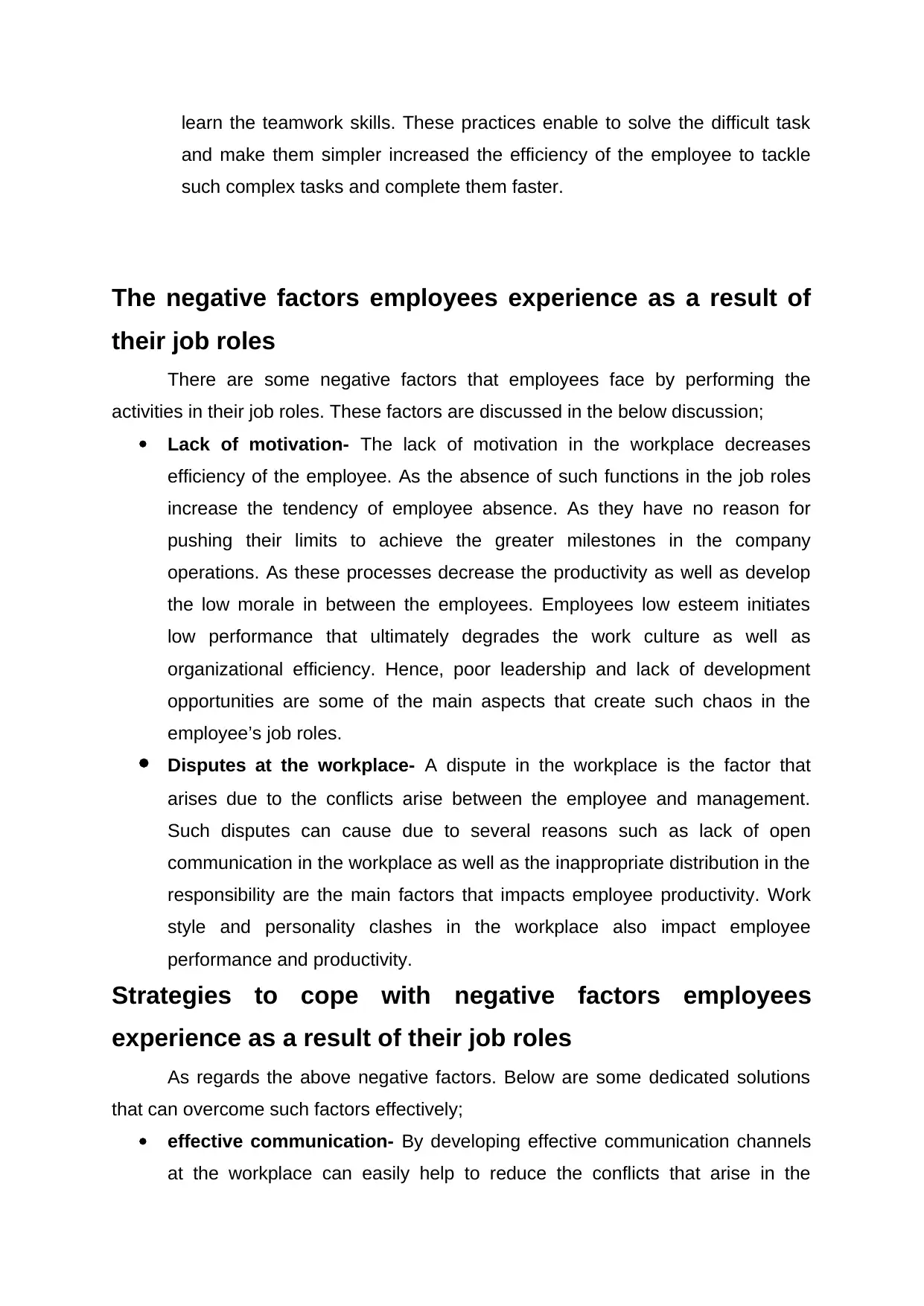
learn the teamwork skills. These practices enable to solve the difficult task
and make them simpler increased the efficiency of the employee to tackle
such complex tasks and complete them faster.
The negative factors employees experience as a result of
their job roles
There are some negative factors that employees face by performing the
activities in their job roles. These factors are discussed in the below discussion;
Lack of motivation- The lack of motivation in the workplace decreases
efficiency of the employee. As the absence of such functions in the job roles
increase the tendency of employee absence. As they have no reason for
pushing their limits to achieve the greater milestones in the company
operations. As these processes decrease the productivity as well as develop
the low morale in between the employees. Employees low esteem initiates
low performance that ultimately degrades the work culture as well as
organizational efficiency. Hence, poor leadership and lack of development
opportunities are some of the main aspects that create such chaos in the
employee’s job roles.
Disputes at the workplace- A dispute in the workplace is the factor that
arises due to the conflicts arise between the employee and management.
Such disputes can cause due to several reasons such as lack of open
communication in the workplace as well as the inappropriate distribution in the
responsibility are the main factors that impacts employee productivity. Work
style and personality clashes in the workplace also impact employee
performance and productivity.
Strategies to cope with negative factors employees
experience as a result of their job roles
As regards the above negative factors. Below are some dedicated solutions
that can overcome such factors effectively;
effective communication- By developing effective communication channels
at the workplace can easily help to reduce the conflicts that arise in the
and make them simpler increased the efficiency of the employee to tackle
such complex tasks and complete them faster.
The negative factors employees experience as a result of
their job roles
There are some negative factors that employees face by performing the
activities in their job roles. These factors are discussed in the below discussion;
Lack of motivation- The lack of motivation in the workplace decreases
efficiency of the employee. As the absence of such functions in the job roles
increase the tendency of employee absence. As they have no reason for
pushing their limits to achieve the greater milestones in the company
operations. As these processes decrease the productivity as well as develop
the low morale in between the employees. Employees low esteem initiates
low performance that ultimately degrades the work culture as well as
organizational efficiency. Hence, poor leadership and lack of development
opportunities are some of the main aspects that create such chaos in the
employee’s job roles.
Disputes at the workplace- A dispute in the workplace is the factor that
arises due to the conflicts arise between the employee and management.
Such disputes can cause due to several reasons such as lack of open
communication in the workplace as well as the inappropriate distribution in the
responsibility are the main factors that impacts employee productivity. Work
style and personality clashes in the workplace also impact employee
performance and productivity.
Strategies to cope with negative factors employees
experience as a result of their job roles
As regards the above negative factors. Below are some dedicated solutions
that can overcome such factors effectively;
effective communication- By developing effective communication channels
at the workplace can easily help to reduce the conflicts that arise in the
⊘ This is a preview!⊘
Do you want full access?
Subscribe today to unlock all pages.

Trusted by 1+ million students worldwide
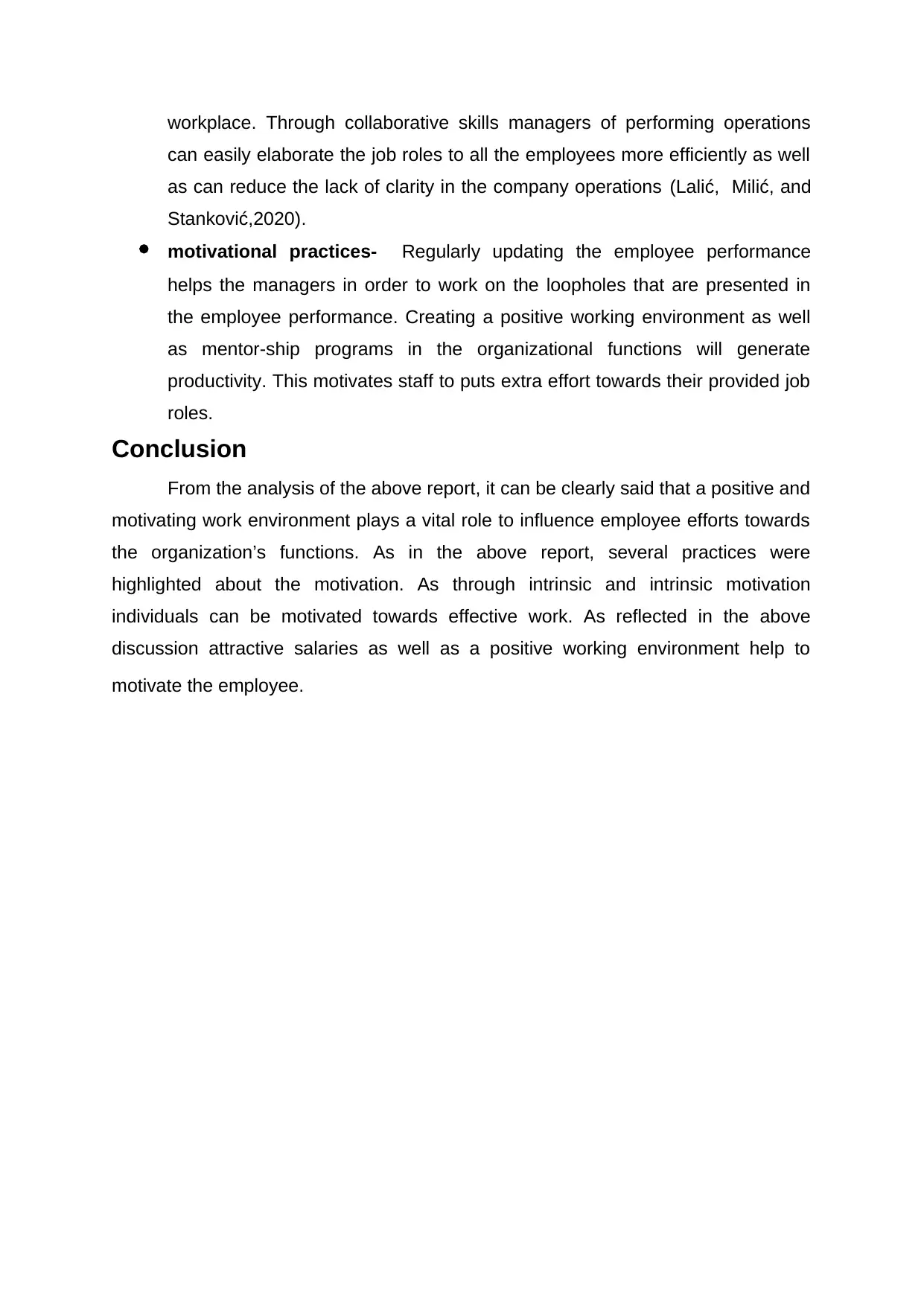
workplace. Through collaborative skills managers of performing operations
can easily elaborate the job roles to all the employees more efficiently as well
as can reduce the lack of clarity in the company operations (Lalić, Milić, and
Stanković,2020).
motivational practices- Regularly updating the employee performance
helps the managers in order to work on the loopholes that are presented in
the employee performance. Creating a positive working environment as well
as mentor-ship programs in the organizational functions will generate
productivity. This motivates staff to puts extra effort towards their provided job
roles.
Conclusion
From the analysis of the above report, it can be clearly said that a positive and
motivating work environment plays a vital role to influence employee efforts towards
the organization’s functions. As in the above report, several practices were
highlighted about the motivation. As through intrinsic and intrinsic motivation
individuals can be motivated towards effective work. As reflected in the above
discussion attractive salaries as well as a positive working environment help to
motivate the employee.
can easily elaborate the job roles to all the employees more efficiently as well
as can reduce the lack of clarity in the company operations (Lalić, Milić, and
Stanković,2020).
motivational practices- Regularly updating the employee performance
helps the managers in order to work on the loopholes that are presented in
the employee performance. Creating a positive working environment as well
as mentor-ship programs in the organizational functions will generate
productivity. This motivates staff to puts extra effort towards their provided job
roles.
Conclusion
From the analysis of the above report, it can be clearly said that a positive and
motivating work environment plays a vital role to influence employee efforts towards
the organization’s functions. As in the above report, several practices were
highlighted about the motivation. As through intrinsic and intrinsic motivation
individuals can be motivated towards effective work. As reflected in the above
discussion attractive salaries as well as a positive working environment help to
motivate the employee.
Paraphrase This Document
Need a fresh take? Get an instant paraphrase of this document with our AI Paraphraser

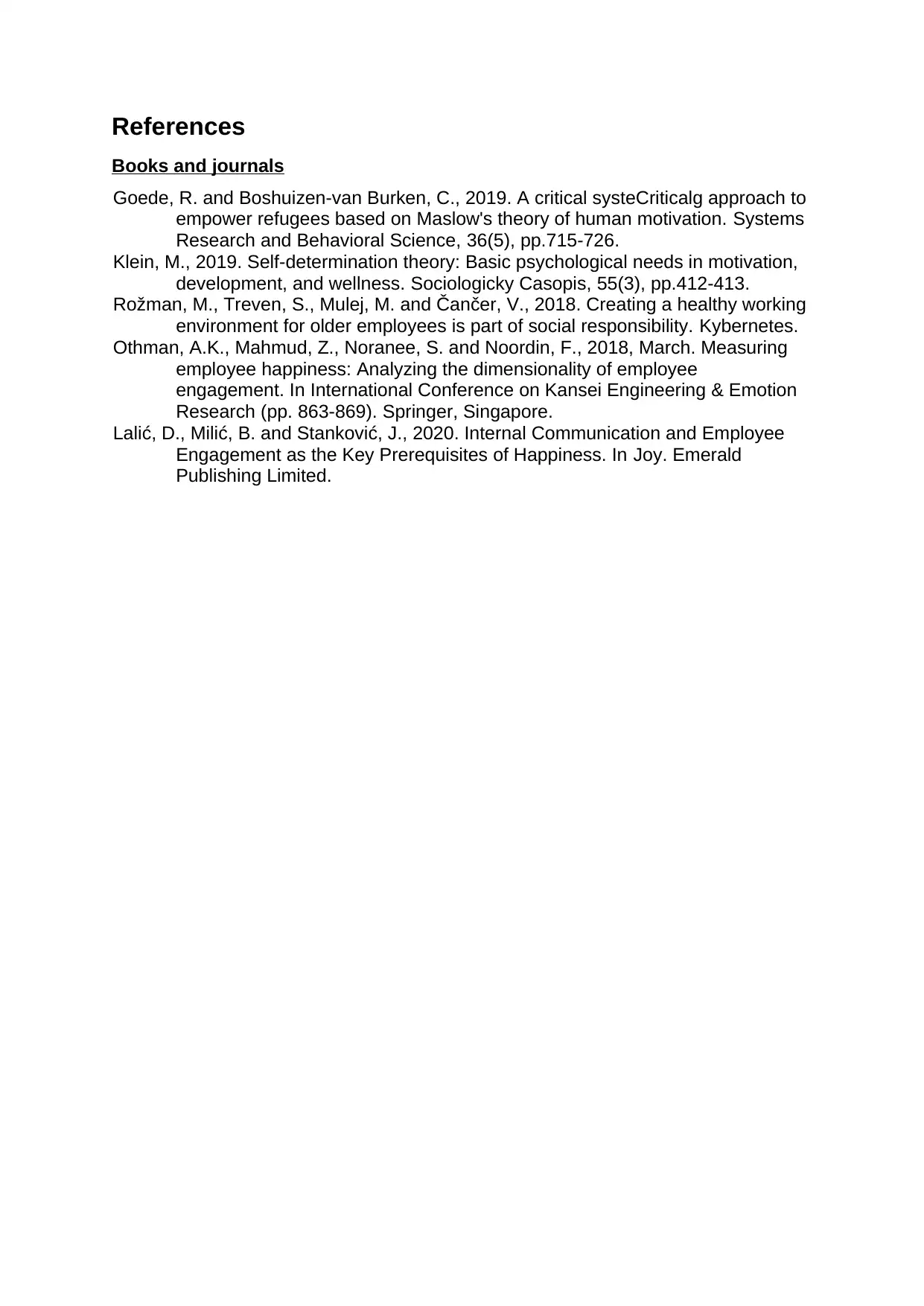
References
Books and journals
Goede, R. and Boshuizen‐van Burken, C., 2019. A critical systeCriticalg approach to
empower refugees based on Maslow's theory of human motivation. Systems
Research and Behavioral Science, 36(5), pp.715-726.
Klein, M., 2019. Self-determination theory: Basic psychological needs in motivation,
development, and wellness. Sociologicky Casopis, 55(3), pp.412-413.
Rožman, M., Treven, S., Mulej, M. and Čančer, V., 2018. Creating a healthy working
environment for older employees is part of social responsibility. Kybernetes.
Othman, A.K., Mahmud, Z., Noranee, S. and Noordin, F., 2018, March. Measuring
employee happiness: Analyzing the dimensionality of employee
engagement. In International Conference on Kansei Engineering & Emotion
Research (pp. 863-869). Springer, Singapore.
Lalić, D., Milić, B. and Stanković, J., 2020. Internal Communication and Employee
Engagement as the Key Prerequisites of Happiness. In Joy. Emerald
Publishing Limited.
Books and journals
Goede, R. and Boshuizen‐van Burken, C., 2019. A critical systeCriticalg approach to
empower refugees based on Maslow's theory of human motivation. Systems
Research and Behavioral Science, 36(5), pp.715-726.
Klein, M., 2019. Self-determination theory: Basic psychological needs in motivation,
development, and wellness. Sociologicky Casopis, 55(3), pp.412-413.
Rožman, M., Treven, S., Mulej, M. and Čančer, V., 2018. Creating a healthy working
environment for older employees is part of social responsibility. Kybernetes.
Othman, A.K., Mahmud, Z., Noranee, S. and Noordin, F., 2018, March. Measuring
employee happiness: Analyzing the dimensionality of employee
engagement. In International Conference on Kansei Engineering & Emotion
Research (pp. 863-869). Springer, Singapore.
Lalić, D., Milić, B. and Stanković, J., 2020. Internal Communication and Employee
Engagement as the Key Prerequisites of Happiness. In Joy. Emerald
Publishing Limited.
⊘ This is a preview!⊘
Do you want full access?
Subscribe today to unlock all pages.

Trusted by 1+ million students worldwide
1 out of 9
Related Documents
Your All-in-One AI-Powered Toolkit for Academic Success.
+13062052269
info@desklib.com
Available 24*7 on WhatsApp / Email
![[object Object]](/_next/static/media/star-bottom.7253800d.svg)
Unlock your academic potential
Copyright © 2020–2025 A2Z Services. All Rights Reserved. Developed and managed by ZUCOL.


